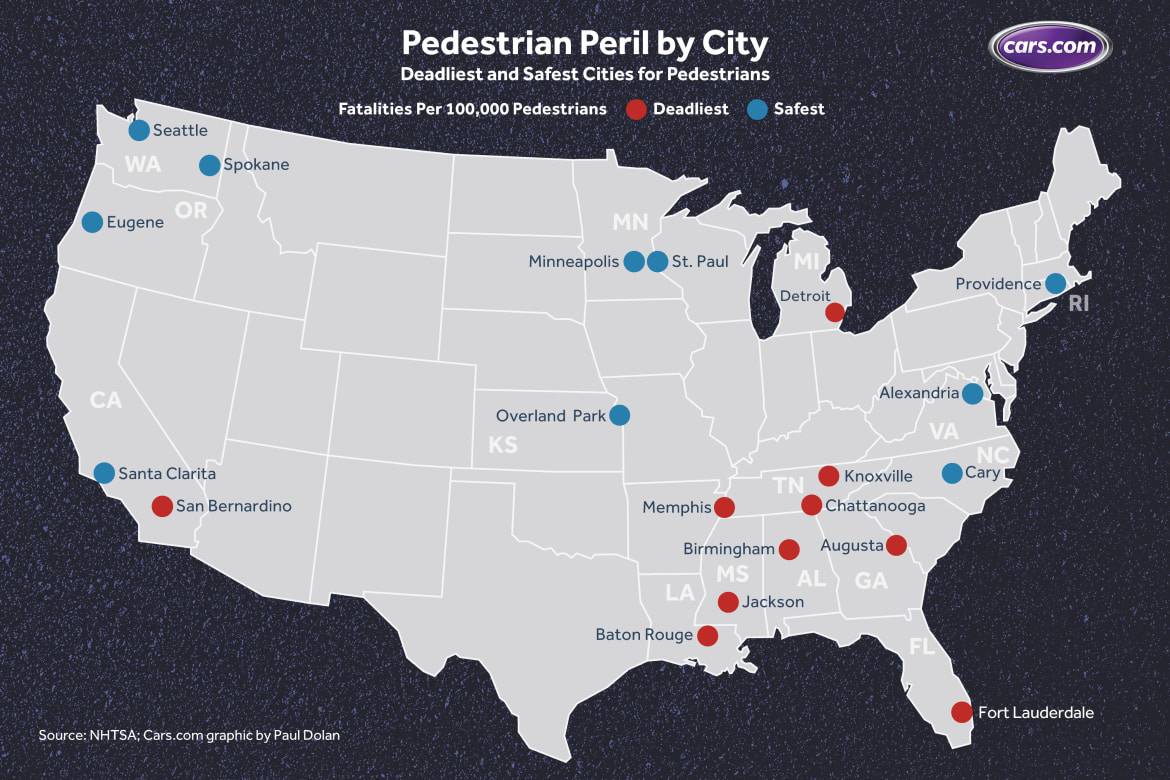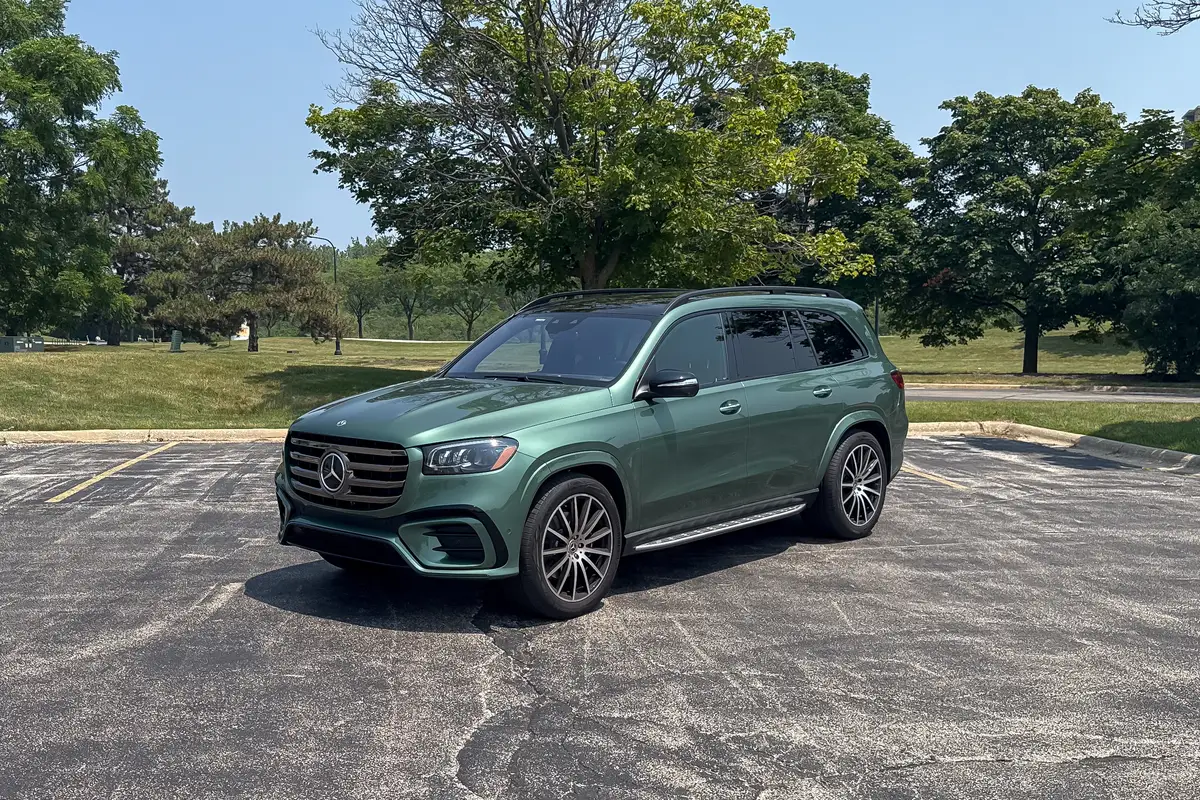Pedestrians, Watch Your Step in These Cities!


CARS.COM — A disturbing trend is afoot for pedestrians. According to the National Highway Traffic Safety Administration’s annual overview of traffic crashes, pedestrian fatalities increased by nearly 10 percent and are at their highest number in two decades.
Related: Which States Had the Biggest, Smallest Increases in 2015 Traffic Deaths?
In 2015, 5,376 pedestrians were killed in car collisions, nearly 500 more than the previous year. The 9.5 percent increase in walking deaths outpaced the overall traffic-fatalities increase last year of 7.2 percent.
So where do pedestrians most need to watch their step? Taken by city — where most of the nation’s residents are concentrated — denizens of Southern states should exercise extra caution. Southern cities lay claim to a whopping 20 of the top 25 most dangerous places for pedestrians, although Detroit had the highest number of walking deaths, with more than 18 deaths per 100,00 residents, according to the most recent full year of city-by-city data available.
The South also claims the two safest cities for pedestrians, with Cary, N.C., landing at No. 2 with just 1.3 deaths per 100,000, and Alexandria, Va., boasting zero deaths per 100,000. The Western U.S. had the greatest proportion of safe cities for pedestrians, with four making that list.
Despite conjuring images of streets packed with cars and taxis darting between cars and cutting off other drivers, the nation’s three largest cities — New York, Los Angeles and Chicago — were on the lower end for pedestrian deaths. New York was best of the three with less than three deaths per 100,000, followed by Chicago with 4.41 and L.A. with slightly more than 6.

The deadliest cities for pedestrians, followed by their fatality rate per 100,000 residents, are:
25. Oklahoma City, 10.96
24. Orlando, Fla., 11.05
23. Louisville, Ky., 11.42
22. Lubbock, Texas, 11.48
21. Phoenix, 11.52
20. Tempe, Ariz., 11.57
19. Atlanta, 11.62
18. St. Louis, 11.66
17. Dallas, 12.02
16. Mobile, Ala., 12.33
15. Jacksonville, Fla., 12.42
14. Shreveport, La., 12.61
13. Tulsa, Okla., 12.76
12. New Orleans, 13.01
11. St. Petersburg, Fla., 13.4
10. Jackson, Miss., 13.44
9. Memphis, Tenn., 13.55
8. Augusta, Ga., 13.72
7. Birmingham, Ala., 14.13
6. Fort Lauderdale, Fla., 14.2
5. Chattanooga, Tenn., 14.39
4. San Bernardino, Calif., 16.26
3. Baton Rouge, La., 17.48
2. Knoxville, Tenn., 17.91
1. Detroit, 18.38
On the other side of the safety spectrum, the least dangerous cities for pedestrians are:
10. Spokane, Wash., 2.83
9. Providence, R.I., 2.79
8. Santa Clarita, Calif., 2.75
7. St. Paul, Minn., 2.69
6. Seattle, 2.69
5. Eugene, Ore., 1.87
4. Minneapolis, 1.72
3. Overland Park, Kan., 1.63
2. Cary, N.C., 1.29
1. Alexandria, Va., 0.0
The pedestrian category accompanied a broader increase in deaths of vehicle non-occupants — which also includes motorcyclists, bicyclists and other victims not riding in cars at the time of the crash — of 5 percent over the past decade. Non-occupant deaths have increased in proportion among total traffic fatalities to a high of 32 percent in 2012 through 2015 compared with a low of 20 percent from 1996 to 2000, NHTSA’s report stated.
The recent increase in overall traffic injuries and fatalities follows a decade of generally declining annual death tolls on U.S. roadways. Fewer than 33,000 people were killed in traffic crashes in 2014 compared with nearly 43,000 in 2006.
“Safety programs such as those that have resulted in increased belt use and reduced impaired driving have worked to substantially lower the number of traffic fatalities over the years,” NHTSA said in a statement. “Vehicle improvements including technologies such as airbags and electronic stability control have also contributed greatly to reduce traffic deaths.”
But that trend was derailed in 2015 when driving deaths spiked to 35,092, according to data from NHTSA’s Fatality Analysis Reporting System. Injuries last year increased by 105,000 over the previous year.
An improved economy and rebounding employment figures have been popularly cited as the general cause of the increase in traffic fatalities, with more and more cars on the road as people head back to work. Vehicle miles from 2014 to 2015 saw their largest increase — 3.5 percent — in nearly a quarter of a century. Meanwhile, distracted driving, impaired driving and failure to use seat belts continue to contribute to the problem despite continued improvement in the latter two categories.
NHTSA spokeswoman Kathryn Henry told Cars.com that researchers are looking into why pedestrian deaths have shot up disproportionately to other driving-death categories.
“We’ve got a call to action for experts to analyze our data and offer reasons for why fatalities are up across the board,” Henry said. “We can’t speculate on why at this point.”
Meanwhile, the picture isn’t improving for 2016. According to early estimates reported in October, the first half of 2016 is on track for a 10.4 percent increase compared with the first half of 2015.

Former Assistant Managing Editor-News Matt Schmitz is a veteran Chicago journalist indulging his curiosity for all things auto while helping to inform car shoppers.
Featured stories



